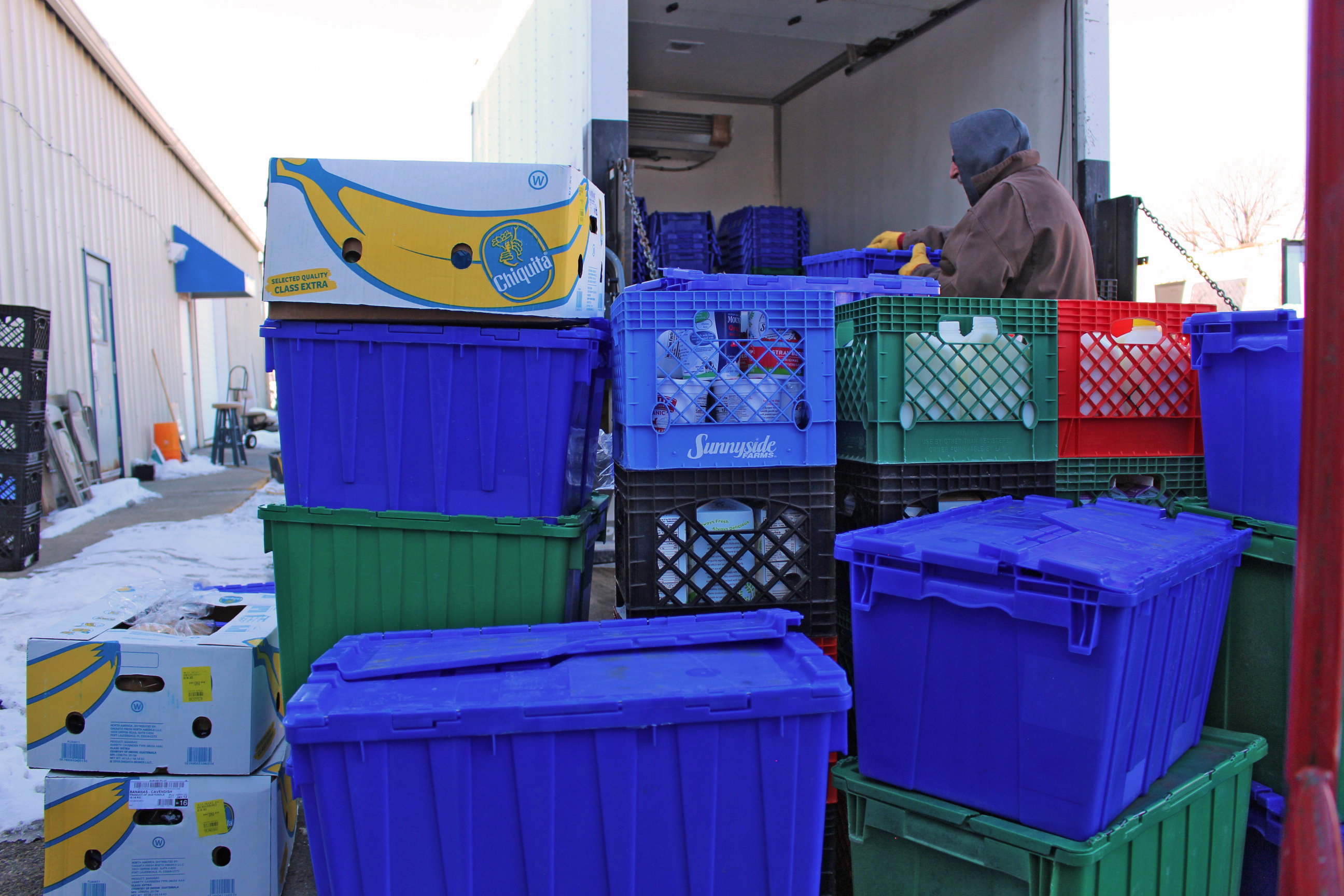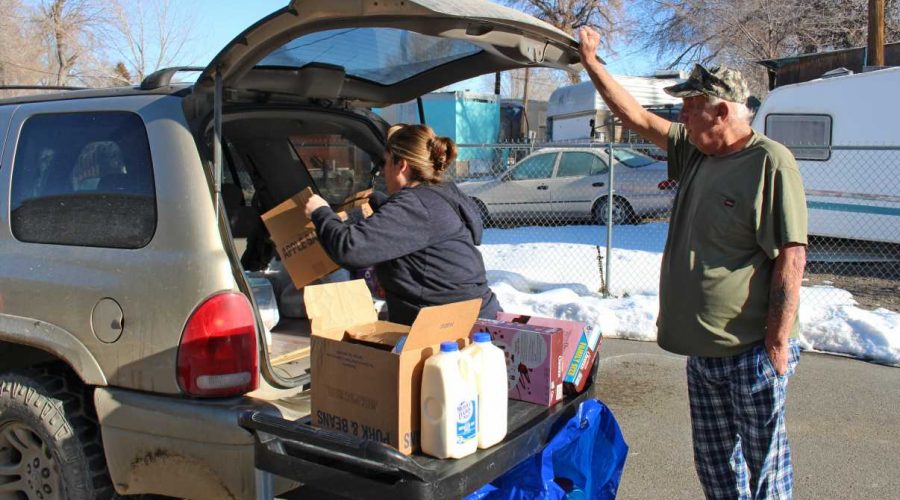Looming Cuts to Emergency SNAP Benefits Threaten Food Security in Rural America
ELKO, Nev. — On a cold morning in early February, Tammy King prepared and loaded boxes and bags of vegetables, fruits, milk, frozen meat, and snacks into cars lined up outside the Friends in Service Helping food pantry, known in rural northeastern Nevada as FISH.
The beginning of the month is busy for the food pantry, King said, because people who receive benefits from the federal Supplemental Nutrition Assistance Program, known as SNAP, come to stock up on free food that helps them stretch their monthly allotments. The food pantry, one of a few in this city of about 20,000 people, serves more families now than at any point in King’s 20 years of working there, she said. In January, FISH provided food boxes to nearly 790 people.
But King and other food bank managers fear that demand will spike further in March, when officials roll back pandemic-era increases to SNAP benefits. The program, administered by the Department of Agriculture, provides monthly stipends to people with low incomes to spend on food. Before 2020, those payments averaged a little more than $200 and were hiked by a minimum of $95 during the pandemic.
Officials estimate families King works with will see a 30% to 40% decrease in SNAP payments as emergency allotments tied to the public health emergency halt in 32 states, including Nevada. Other states, such as Georgia, Indiana, Montana, and South Dakota, have already ended the emergency allotments.
The cuts to SNAP benefits will uniquely hurt people living in rural America, said Andrew Cheyne, managing director of public policy for GRACE, a nonprofit run by the Daughters of Charity of St. Vincent de Paul focused on reducing childhood hunger. A higher percentage of people depend on SNAP in rural areas compared with metro areas. And those areas already have higher rates of food insecurity and poverty.
“We have so many households who simply aren’t going to know that this is happening,” Cheyne said. “They’re going to go to the grocery store and expect to have money in their account and not be able to buy the food they need to feed their families.”
And as the fallout from those cuts hits, food pantry managers in rural areas find themselves on the front lines trying to fill gaps in their communities. They and food policy experts fear it won’t be enough. For every dollar worth of groceries a food bank distributes to a community, SNAP delivers $9.
“There’s just no comparing the scale of SNAP to the charitable food sector,” Cheyne said. “It’s simply not possible to make up that difference.”
Email Sign-Up
Subscribe to KHN's free Morning Briefing.
Each household’s benefits will drop by at least $95 per month, with some households absorbing as much as a $250 reduction, according to the Center on Budget and Policy Priorities.
“There’s no way, that I see, that we’re ever going to make up fully for what’s being lost,” said Ellen Vollinger, SNAP director for the Food Research & Action Center, an anti-hunger nonprofit in Washington, D.C.
The cuts will reduce payments to households that receive assistance to an average of about $6 per person, per day, Vollinger said, adding that $2 per meal isn’t enough to feed a person, especially given other factors, like rising fuel, rent, and grocery prices. Some older adults, she said, will see the most precipitous drop in benefits, going from $280 a month to $23.
Chasity Harris, 42, said the $519 in benefits she has received monthly since October makes a big difference for her and her granddaughter. Once the emergency allotment is cut, she said, she knows she can do what it takes to make sure there’s food on the table in her home but that doesn’t mean it’ll be easy.
“You can’t eat healthy without having a nice little budget,” Harris said. “Bad food is cheap. Just because I can manage doesn’t mean I’m getting everything that we need. I’m buying the cheapest stuff.”
A study published by the Urban Institute estimated that the SNAP emergency allotments helped more than 4 million people stay above the poverty line in late 2021. Non-Hispanic Black and Hispanic people saw the biggest reduction in poverty levels, according to the study.
In Montana, the expanded SNAP benefits were cut in summer 2021. Brent Weisgram, vice president and chief operating officer of the Montana Food Bank Network, said that reporting from the network’s partners shows a 24% increase in the number of households seeking assistance from emergency food pantries from July 2021 to July 2022.
Weisgram said food pantries are not prepared to absorb the impact of the cut to the largest federal nutrition assistance program and are strictly a supplemental resource.
Food banks nationwide are still coping with increased demand that began in 2020, Cheyne said. That lingering need from the pandemic, coupled with food price inflation, leaves food pantries less prepared for demand resulting from cuts to the SNAP emergency allotments.

While the FISH food pantry has enough meat for families now, King said, she worries about whether it’ll be enough six months from now. On a scale of 1 to 10, King said, her level of concern regarding the consequences of the looming SNAP cuts is a 9.
If history is any indication, her concerns are valid.
In 2009, SNAP recipients received, on average, about 15% to 20% more in benefits as the federal government responded to the challenges of the Great Recession. A family of four received $80 more a month in benefits. In 2013, the government rolled the boosted benefits back, averaging a 7% cut for households. The effects were immediate and long-term, Cheyne said, including significant spikes in food insecurity and poverty-related hunger that lasted for nearly a decade.
The cuts this time around are much greater than in 2013 and there’s much less time for states to prepare, making it more difficult to ensure SNAP recipients are aware of the benefits they’re about to lose.
While families and individuals are expected to turn elsewhere, like food banks, other aid organizations face challenges brought on by inflation and rising food costs.
The Food Bank of Northern Nevada, which helps supply food pantries in smaller communities, including FISH, has seen a drop in food donations during the past six months, said Jocelyn Lantrip, director of marketing and communications for the food bank. Staffers are “scrambling” to source and buy enough food to meet the expected increase in demand, she said.
King said the FISH food pantry will depend on donations because its grant dollars aren’t stretching as far as they used to because of inflation. But they’ll do everything they can to meet the needs of their community, which go far beyond food assistance. The food boxes are just a spoke on the wheel of services FISH and other food pantries provide, such as assistance with signing up for SNAP and other benefit programs, housing, and referrals to mental health providers.
Despite the challenging road ahead for the small food pantry, King is hopeful.
“I feel that everybody who has the power to help is doing everything they can to help us,” she said. “You just gotta look at your food and say, ‘OK, how long can I make this last and make a difference in someone’s life?’”
Source: Read Full Article
